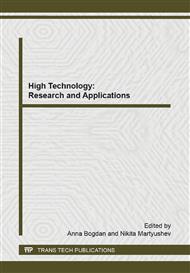[1]
G. Frenning, Modelling drug release from inert matrix systems: From moving-boundary to continuous-field descriptions Intern. J. Pharmaceutics 418 (2011) 88-99.
DOI: 10.1016/j.ijpharm.2010.11.030
Google Scholar
[2]
M.A. Mujeebu, M.Z. Abdullah, M.Z. Abu Bakar, A.A. Mohamad, M.K. Abdullah, Applications of porous media combustion technology - A review. Appl. Energy 86 (2009) 1365-1375.
DOI: 10.1016/j.apenergy.2009.01.017
Google Scholar
[3]
V.N. Bogomolov, Liquids in ultrathin channels (Filament and cluster crystals). Sov. Physics Uspekhi 21 (1978) 77-83.
DOI: 10.1070/pu1978v021n01abeh005510
Google Scholar
[4]
A.D. Yoffe, Semiconductor quantum dots and related systems: electronic, optical, luminescence and related properties of low dimensional systems. Adv. Phys. 50 (2001) 1-208.
DOI: 10.1080/00018730010006608
Google Scholar
[5]
M.S. Ivanova, Y.A. Kumzerov, V.V. Poborchii, Y.V. Ulashkevich, V.V. Zhuravlev, Ultrathin wires incorporated within chrysotile asbestos nanotubes: optical and electrical properties. Micropor. Mater. 4 (1995) 319-322.
DOI: 10.1016/0927-6513(95)00008-w
Google Scholar
[6]
S. Borisov, T. Hansen, Yu. Kumzerov, A. Naberezhnov, V. Simkin, O. Smirnov, A. Sotnikov, M. Tovar, S. Vakhrushev, Neutron diffraction study of NaNO2 ferroelectric nanowires. Phys. B: Cond. Matter 350 (2004) E1119–E1121.
DOI: 10.1016/j.physb.2004.03.304
Google Scholar
[7]
V. Belotitskii, Yu. Kumzerov, A. Fokin Optical second-harmonic generation in ferroelectric nanowires. JETP Lett. 87 (2008) 399-402.
DOI: 10.1134/s002136400808002x
Google Scholar
[8]
A.A. Starovoytov, V.I. Belotitskii, Yu.A. Kumzerov, A.A. Sysoeva, Optical properties of polymethine molecules incorporated into a macroscopic set of parallel nanotubes. Optic. Spectrosc. 113 (2012) 512-516.
DOI: 10.1134/s0030400x12090159
Google Scholar
[9]
D. Bernstein, J. Dunnigan, T. Hesterberg, R. Brown, J. Legaspi-Velasco, R. Barrera, J. Hoskins, A. Gibbs, Health risk of chrysotile revisited. Crit. Rev. Toxicol. 43 (2013) 154–183.
DOI: 10.3109/10408444.2013.826178
Google Scholar
[10]
S. Pereira da Silva, A. Wander, R. Bisatto, G. Barrera-Galland, Preparation and characterization of chrysotile for use as nanofiller in polyolefins. Nanotechnology 22 (2011) 105701.
DOI: 10.1088/0957-4484/22/10/105701
Google Scholar
[11]
F.L.B. Wypych, N. Adad Mattoso, A.A.S. Marangon, W.H. Schreiner, Synthesis and characterization of disordered layered silica obtained by selective leaching of octahedral sheets from chrysotile and phlogopite structures. J. Coll. Interface Sci. 283 (2005).
DOI: 10.1016/j.jcis.2004.08.139
Google Scholar
[12]
V. Bogomolov, V. Petranovskii. A method for manufacturing silicate fibers from natural chrysotile. Patent RU 2010777, (1994).
Google Scholar
[13]
K. Yada, Study of Chrysotile Asbestos by a High Resolution Electron Microscope. Acta Cryst. 23 (1967) 704-707.
DOI: 10.1107/s0365110x67003524
Google Scholar
[14]
L.E. Murr, K.F. Soto, TEM comparison of chrysotile (asbestos) nanotubes and carbon nanotubes J. Mater. Sci. 39 (2004) 4941-4947.
DOI: 10.1023/b:jmsc.0000035342.99587.96
Google Scholar
[15]
John W. Anthony, Richard A. Bideaux, Kenneth W. Bladh, and Monte C. Nichols, Eds., Handbook of Mineralogy, Mineralogical Society of America, Chantilly, VA 20151-1110, USA. http: /www. handbookofmineralogy. org.
Google Scholar
[16]
E.J.W. Whittalar, Structure and properties of asbestos. Published in: Handbook of Textile Fibre Structure, Volume 2: Natural, Regenerated, Inorganic, and Specialist Fibres. Ed. by S. Eichhorn, J.W.S. Hearle, M. Jaffe, T. Kikutani. Woodhead Publishing, New Delhi, India, 2009, pp.425-449.
DOI: 10.1533/9781845696504
Google Scholar


